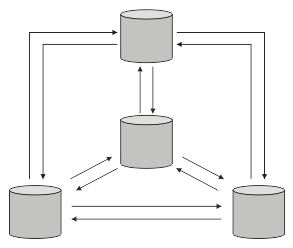How to choose cluster queue managers to hold full repositories
In each cluster you must choose at least one, and preferably two queue managers to hold full repositories. Two full repositories are sufficient for all but the most exceptional circumstances. If possible, choose queue managers that are hosted on robust and permanently-connected platforms, that do not have coinciding outages, and that are in a central position geographically. Also consider dedicating systems as full repository hosts, and not using these systems for any other tasks.
Full repositories are queue managers that maintain a complete picture of the state of the cluster. To share this information, each full repository is connected by CLUSSDR channels (and their corresponding CLUSRCVR definitions) to every other full repository in the cluster. You must manually define these channels.

Every other queue manager in the cluster maintains a picture of what it currently knows about the state of the cluster in a partial repository. These queue managers publish information about themselves, and request information about other queue managers, using any two available full repositories. If a chosen full repository is not available, another is used. When the chosen full repository becomes available again, it collects the latest new and changed information from the others so that they keep in step. If all the full repositories go out of service, the other queue managers use the information they have in their partial repositories. However, they are limited to using the information that they have; new information and requests for updates cannot be processed. When the full repositories reconnect to the network, messages are exchanged to bring all repositories (both full and partial) up to date.
- The queue managers chosen to hold full repositories need to be reliable and managed. Choose queue managers that are hosted on a robust and permanently-connected platform.
- Consider the planned outages for the systems hosting your full repositories, and ensure that they do not have coinciding outages.
- Consider network performance: Choose queue managers that are in a central position geographically, or that share the same system as other queue managers in the cluster.
- Consider whether a queue manager is a member of more than one cluster. It can be administratively convenient to use the same queue manager to host the full repositories for several clusters, provided this benefit is balanced against how busy you expect the queue manager to be.
- Consider dedicating some systems to contain only full repositories, and not using these systems for any other tasks. This ensures that these systems only require maintenance for queue manager configuration, and are not removed from service for the maintenance of other business applications. It also ensures that the task of maintaining the repository does not compete with applications for system resources. This can be particularly beneficial in large clusters (say, clusters of more than a thousand queue managers), where full repositories have a much higher workload in maintaining the cluster state.
Having more than two full repositories is possible, but rarely recommended. Although object definitions (that is, queues, topics and channels) flow to all available full repositories, requests only flow from a partial repository to a maximum of two full repositories. This means that, when more than two full repositories are defined, and any two full repositories become unavailable, some partial repositories might not receive updates they would expect. See MQ Clusters: Why only two Full Repositories?
One situation in which you might find it useful to define more than two full repositories is when migrating existing full repositories to new hardware or new queue managers. In this case, you should introduce the replacement full repositories, and confirm that they have become fully populated, before you remove the previous full repositories. Whenever you add a full repository, remember that you must directly connect it to every other full repository with CLUSSDR channels.
